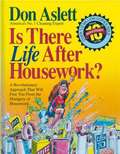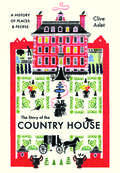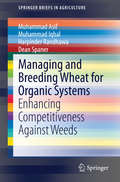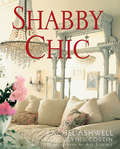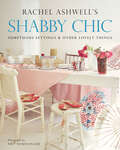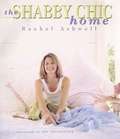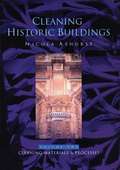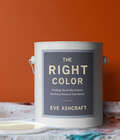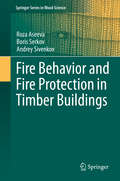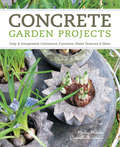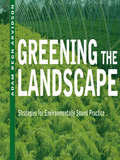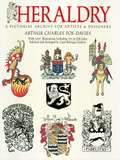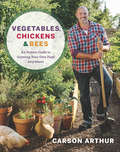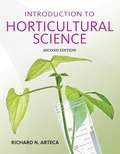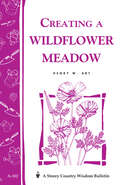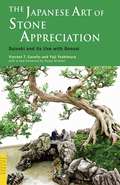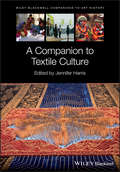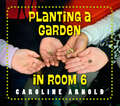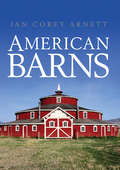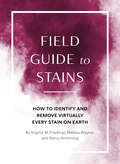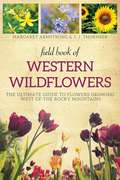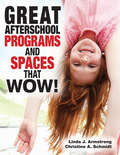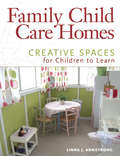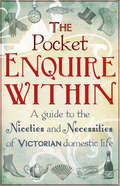- Table View
- List View
Is There Life after Housework? (10th Anniversary Edition)
by Don AslettDon Aslett has won the hearts of millions by showing them how to save up to 75% of the time they spend on housework with the help of his cleaning classic, Is There Life After Housework? Here you will find a revolutionary approach that frees you from the drudgery of housework by bringing the efficient methods and materials of the professional cleaner into the home, plus step-by-step instructions on how to clean every area of your home. How to find the life? Professional secrets to clean faster and better? How to speed-clean the house for company? The right way to do every household chore? Where to get professional tools and supplies ? How to choose and use chemicals that will do the work for you? How to get others to help? Quick checklists and charts for at-a-glance reference .
The Story of the Country House: A History of Places and People
by Clive AsletThe fascinating story of the evolution of the country house in Britain, from its Roman precursors to the presentThe Story of the Country House is an authoritative and vivid account of the British country house, exploring how they have evolved with the changing political and economic landscape. Clive Aslet reveals the captivating stories behind individual houses, their architects, and occupants, and paints a vivid picture of the wider context in which the country house in Britain flourished and subsequently fell into decline before enjoying a renaissance in the twenty-first century. The genesis, style, and purpose of architectural masterpieces such as Hardwick Hall, Hatfield House, and Chatsworth are explored, alongside the numerous country houses lost to war and economic decline. We also meet a cavalcade of characters, owners with all their dynastic obsessions and diverse sources of wealth, and architects such as Inigo Jones, Sir John Vanbrugh, Robert Adam, Sir John Soane and A.W.N. Pugin, who dazzled or in some cases outraged their contemporaries. The Story of the Country House takes a fresh look at this enduringly popular building type, exploring why it continues to hold such fascination for us today.
Managing and Breeding Wheat for Organic Systems
by Muhammad Asif Muhammad Iqbal Harpinder Randhawa Dean SpanerGenetically uniform cultivars in many self-pollinated cereal crops dominate commercial production in high-input environments especially due to their high grain yields and wide geographical adaptation. These cultivars generally perform well under favorable and high-input farming systems but their optimal performance cannot be achieved on marginal/organic lands or without the use of external chemical inputs (fertilizers, herbicides and pesticides). Cereal breeding programs aim at evaluating candidate lines/cultivars for agronomic, disease and quality traits in a weed free environment that makes it impossible to identify traits conferring competitive ability against weeds. Moreover, quantification of competitive ability is a complex phenomenon which is affected by range of growth traits. Above (e. g. light) and below (e. g. water and nutrients) ground resources also influence competitiveness to a greater extent. Competitiveness is quantitatively inherited trait which is heavily influenced by many factors including genotype, management, environment and their interaction. Sound plant breeding techniques and good experimental designs are prerequisites for maximizing genetic gains to breed cultivars for organically managed lands. The brief is focused on breeding wheat for enhanced competitive ability along with other agronomic, genetic and molecular studies that have been undertaken to improve weed suppression, disease resistance and quality in organically managed lands. The examples from other cereals have also been highlighted to compare wheat with other cereal crops.
Shabby Chic
by Rachel AshwellValuable flea market finds... A peeling, antioue vanity in muted sea green... An elegant, cracked chandelier... An enormous, slipcovered sofa with deep, cushions... Comfort, the beauty of imperfections, the allure of time-worn objects, and the appeal of simple practical living: these are the cornerstones of what has come to be known as the Shabby Chic style. Like the cozy familiarity of a well-worn pair of faded jeans, the dilapidated elegance of an Italian viIla, or the worn grandeur of faded velvets and mismatched floral china handed down from your grandmother's attic, the Shabby Chic style is a revived appreciation for what is used, well-loved, and worn. It is a respect for natural evolution and a regard for what is easy and sensible. The hundreds of lavish photographs in this book invite you inside the unique world of Shabby Chic. Rachel Ashwell, founder of theShabby Chic home decor stores, for the first time provides her invaluable and much-sought-after advice on how to re-create Shabby Chic style in your own home. With engaging text and easy-to- follow instructions, Rachel details the Shabby Chic basics in a way that will put even the most apprehensive or novice decorators at ease. From flowers to fabrics to lighting, Rachel illuminates all of the elements essential to this unpretentious yet truly exquisite style. A behind-the-scenes look at a flea market lets readers in on Rachel's personal secrets of how to cull hidden treasures from flea market trash--an old trunk, its paint peeling around the edges, can be given new life as a coffee table, while a chipped white iron salvage piece becomes the perfect frame for a vintage mirror. This book tells you not only how to restore these pieces but how to find the perfect place for them in your home. Gorgeous color photographs and accompanying text reveal how this relaxed look works with a variety of different styles, from Victorian to Mediterranean to contemporary.
Shabby Chic: Sumptuous Settings And Other Lovely Things
by Rachel AshwellCreating beautiful, sumptuous settings for any occasion!Top designer Rachel Ashwell, founder of the Shabby Chic line, is known for her trademark style of transforming drab interiors into warm, inviting spaces. Simply by incorporating a few design elements and a splash of color, Rachel is able to make any environment, whether it's a home or a special event, beautiful and fun. In Shabby Chic: Sumptuous Settings and Other Lovely Things, Rachel proves that her style isn't simply about creating an attractive home but also about creating joyful and pleasant settings for those we love. In this beautiful volume, Rachel applies her distinct eye for style to six very different locations and celebrations, and offers helpful tips on how to host whimsical and unforgettable events.Whether it is casual or formal, big or small, this beautiful book proves that entertaining need not be expensive. From flea markets to local antiques malls, Rachel reveals that the trick to making any event or space something elegant—without breaking the bank—is simply a matter of inspiration, imagination, and the discovery of a fabulous buy.Inside, you'll find practical ideas for any occasion, baby showers to weddings, birthday parties to bar mitzvahs. When it comes to setting a scene, Rachel is an expert and with her easy how-to advice, you can be too.Rachel Ashwell is the creator of the Shabby Chic style. In 1989, she founded the Shabby Chic home furnishing stores and then later, the Rachel Ashwell Shabby Chic Couture stores. She is the author of Shabby Chic, Rachel Ashwell's Shabby Chic Treasure Hunting and Decorating Guide, The Shabby Chic Home, and Shabby Chic: The Gift of Giving.
The Shabby Chic Home
by Rachel AshwellWonderful wide-plank floors, paned sash windows, an old brick fireplace, the charm of living with a home's small imperfections and making them a virtue. These are just some examples of what makes up a Shabby Chic home. When she first saw what would be her future home, Rachel Ashwell, founder of the Shabby Chic line, was put off by its dark, witchy exterior, gloomy interior, and overgrown garden. But for weeks afterward, she couldn't get the house out of her mind. She went back, took a closer look, and started to see the charm that lay hidden beneath the surface. Excited by the challenge, she bought the house and went to work on it. Inspired by the original design of the 1920s house, Rachel was able to transform it into her bright, cozy dream home, one that had the hallmarks of a Shabby Chic home: a practical amount of space, a relaxed atmosphere, and a comfortable beauty. Through simple instructions and detailed before-and-after photographs, Rachel reveals her decorating and entertaining secrets. Even the most apprehensive novices will learn how to incorporate Shabby Chic style into their everyday life and home. Using her home as an example, Rachel shows you how to assess what needs to be replaced (in her home it was the dark tile in the pool and the bathroom doorknobs), make small structural changes (she exchanged a glass window for a glass door), and keep costs down while adding personal Shabby Chic touches. The gray marble countertop in the guest bathroom and the somewhat noisy glass-front refrigerator were fixtures she would have never chosen, but she left them alone and was pleasantly surprised by the character they added. In her previous books, Rachel showed you how to recognize beauty in overlooked places. Now, in The Shabby Chic Home, she teaches you how to find it in the nooks and crannies of your own home and then apply it to everyday life. She reveals how work, love, a lot of white paint, and Shabby Chic details can turn any new house into a comfortable, functional, beautifully designed home.
Cleaning Historic Buildings: v. 2
by Nicola AshurstWhat happens to the fabric of a historic building if it is not cleaned? What is soiling, how does it affect the building? What cleaning methods should be used? This second of a comprehensive two-volume guide addresses these important and controversial questions, along with many others, and offers practical guidance on appropriate cleaning techniques, backed up with useful case study material. Based on the author's extensive on-site involvement at trial and contract stage in many cleaning and surface repair project, this book examines the various attitudes and current cleaning practices, along with the role and need for analysis of substrates and soiling. It also offers advice on dealing with special cleaning problems, such as the removal of paint, graffiti and metallic stains, and provides an assesment of the cleaning methods currently available.
The Right Color
by Eve AshcraftThe definitive guide to paint by the nation’s most sought-after color consultantWhen Martha Stewart was developing her first paint collection, the Araucana Colors (based on the hues of her chickens’ eggs), she turned to the nation’s top color consultant: Eve Ashcraft. Eve helped Martha to pinpoint the colors of that enormously successful paint line, thus assisting in transforming an industry along the way. In her first book, The Right Color, her own curated palette (her paint line launches this fall) and countless other favorite shades and color combinations provide inspiration for every room in the house. Packed with trade secrets, such as how to make a small room look bigger, how to use color to brighten a space, and how to use paint to resolve myriad architectural challenges, this book will give anyone the confidence to choose a palette that will make the most of any space.
Fire Behavior and Fire Protection in Timber Buildings
by Roza Aseeva Boris Serkov Andrey SivenkovThis volume describes fire behavior and fire protection of timbers in outdoors and indoors application mainly in construction industry. The Authors' novel approach considers the relationship between various species and age of timbers and its fire behavior at different thermal and fire loads. Quantitative data of ignition speed and flame propagation as well as generation of heat, smoke and toxic products are discussed. Analysis of fire resistance of various types of building materials based on timber of different species as well as the novel data on the effect of natural and accelerated aging of timbers on its fire behavior are discussed. The main practical methods of fire protection of new and ancient timber buildings and structures to increase its fire resistance are considered. The book should be useful for a wide range of readers: chemists, physicists, material scientists, architects, engineers, constructors and restorers.
Concrete Garden Projects: Easy & Inexpensive Containers, Furniture, Water Features & More
by Camilla Arvidsson Malin NilssonFor gardeners and backyard do-it-yourselfers, concrete is a revelation. It's durable, weatherproof, impossible to steal, and it provides much-needed insulation for outdoor plants. Concrete weathers beautifully, softening around the edges, developing moss, and becoming more picturesque with age.Concrete Garden Projects takes advantage of concrete's numerous assets, showcasing an inspiring array of creative options. The step-by-step instructions for dozens of easy, do-it-yourself décor ideas include containers of all shapes and sizes, elegant benches and stools, miniature ponds and birdbaths, stepping stones, a barbecue, and a fire pit. The authors use a variety of molds easily found or made, household items like bowls and baking pans, and simple wooden frames and boxes. At pennies per pound, and so simple to use—just mix with water and pour—concrete is the key to hand-crafted backyard décor.
Greening the Landscape: Strategies for Environmentally Sound Practice
by Adam Regn ArvidsonA guide to improving the environmental performance of any landscape through the use of green construction and maintenance. Landscapes create obvious environmental benefits but can have unrecognized negative impacts. Adam Regn Arvidson outlines the five primary problem issues--plant pots, vehicle fuel, energy consumption, water/fertilizer use, and green waste--and details a variety of practices, ranging from exceedingly simple ideas to long-term investments, for making the installation and upkeep of landscapes more green. A companion website, GreeningtheLandscapeBook.com, provides readers with additional resources and case studies, arranged by environmental impact and geography.
Heraldry: A Pictorial Archive for Artists and Designers (Dover Pictorial Archive)
by Arthur Charles Fox-DaviesRoyalty-free treasury of 393 full-color, 654 black-and-white illustrations. Authentic heraldic arms, lions, eagles, dragons, shields, crests, windows, etc. Also, arms of cities and towns, arms of Edward the Black Prince, Milton, Maximilian I, others. Add aristocratic flair, noble bearing to almost any graphic project. Publisher's Note. Captions.
Vegetables, Chickens & Bees: An Honest Guide to Growing Your Own Food Anywhere
by Carson ArthurFor anyone who's ever wanted to grow their own food, comes gardening guru Carson Arthur's honest, and often hilarious, advice for any and every skill level and space.Everyone appreciates the glory of a fresh vine-ripened vegetable, but how do you successfully grow your own? Nobody wants to see their vegetable dreams die the tragic death of a #gardenfail! That is where Carson Arthur comes in, with a wealth of knowledge to guide your gardening decisions and set you up for success in any space. Whether it's a backyard, a rooftop, a balcony or even just a window ledge, this book has everything you need to know about sunlight, space, soil, seeds, and setup. Six years ago, Carson bought a small plot of land two hours outside of the city to try his hand at having his own farm. As a gardener by trade, and with a childhood spent on an apple farm, he had a little experience to back him up! Now he's sharing all of that in Vegetables, Chickens & Bees. Carson provides very real advice on how to choose the right garden for you, how to prepare your dirt and seeds, and gives step-by-step guidance for 20 key veggies you can grow--as well as how to dodge the many pitfalls out there (like checking about the locations of cable wires and gas lines before you start digging up your yard.) Then he shares his favourite recipes for those vegetables so you can have delicious options for everything you grow. Also included are primers on raising your own chickens and keeping your own bees.
Introduction to Horticultural Science (Second Edition)
by Richard N. ArtecaDesigned to provide readers with a full appreciation of the wonderful world of horticultural science, the Second Edition of INTRODUCTION TO HORTICULTURAL SCIENCE covers everything the reader needs to know in a comprehensive format that is easy to understand. Coverage includes critical topics such as fundamental concepts, cutting edge research, careers in horticulture, the relationship between horticulture and the environment, classification of plants, and plant anatomy. Readers are also introduced to key concepts such as plant propagation, media, nutrients and fertilizers, plants and the environment, plant growth regulators, post harvest physiology and pest management, greenhouse structures, nursery site selection, development and facilities, producing nursery crops, and floral design. Through enhanced visual aids and the inclusion of recent trends in the field, the second edition has been designed to peak reader interest and improve reader understanding.
Creating a Wildflower Meadow: Storey's Country Wisdom Bulletin A-102
by Henry W. ArtSince 1973, Storey's Country Wisdom Bulletins have offered practical, hands-on instructions designed to help readers master dozens of country living skills quickly and easily. There are now more than 170 titles in this series, and their remarkable popularity reflects the common desire of country and city dwellers alike to cultivate personal independence in everyday life.
The Japanese Art of Stone Appreciation: Suiseki and its Use with Bonsai (Tuttle Classics)
by Sonja Arntzen Vincent T. Covello Yuji YoshimuraThe Japanese Art of Stone Appreciation is an exploration into the art of suiseki--small, naturally formed stones selected for their shape, balance, simplicity and tranquility.<P><P>Written by two leading experts in the field of Japanese gardening and art, this concise introduction offers aesthetic guidance and direct practical advice that is a window into traditional Japanese culture. It details the essential characteristics of a high-quality suiseki, describing the various systems of stone classification in this Japanese art form and explaining how to display a suiseki to its best advantage. There is also a section on incorporating suiseki alongside a bonsai tree, the most popular and rewarding complement to peaceful suiseki miniature landscape gardens.Sections include:Historical BackgroundCharacteristics and Aesthetic QualitiesClassification of SuisekiDisplaying a StoneSuiseki with Bonsai and Other Related ArtsCollecting SuisekiHow to Make a Carved Wooden BaseSuiseki Classification Systems
A Companion to Textile Culture (Blackwell Companions to Art History)
by Dana ArnoldA lively and innovative collection of new and recent writings on the cultural contexts of textiles The study of textile culture is a dynamic field of scholarship which spans disciplines and crosses traditional academic boundaries. A Companion to Textile Culture is an expertly curated compendium of new scholarship on both the historical and contemporary cultural dimensions of textiles, bringing together the work of an interdisciplinary team of recognized experts in the field. The Companion provides an expansive examination of textiles within the broader area of visual and material culture, and addresses key issues central to the contemporary study of the subject. A wide range of methodological and theoretical approaches to the subject are explored—technological, anthropological, philosophical, and psychoanalytical, amongst others—and developments that have influenced academic writing about textiles over the past decade are discussed in detail. Uniquely, the text embraces archaeological textiles from the first millennium AD as well as contemporary art and performance work that is still ongoing. This authoritative volume: Offers a balanced presentation of writings from academics, artists, and curators Presents writings from disciplines including histories of art and design, world history, anthropology, archaeology, and literary studies Covers an exceptionally broad chronological and geographical range Provides diverse global, transnational, and narrative perspectives Included numerous images throughout the text to illustrate key concepts A Companion to Textile Culture is an essential resource for undergraduate and postgraduate students, instructors, and researchers of textile history, contemporary textiles, art and design, visual and material culture, textile crafts, and museology.
Planting a Garden in Room 6: From Seeds to Salad (Life Cycles in Room 6)
by Caroline ArnoldKindergarteners learn the joys of gardening in this close-up look at how plants grow.A visit to Mrs. Best's classroom is always inspiring! Follow a classroom of real kindergartners as they grow a garden full of healthy vegetables. Joyful photographs show kids planting seeds, tending the seedlings, and harvesting (and eating!) the results. An exciting introduction to the math and science involved in growing a garden. The Life Cycles in Room 6 series follows Mrs. Best&’s real kindergarten class as they help things grow. This photo-illustrated series engages readers with hands-on science in the classroom and beyond.
American Barns
by Jan ArnettThe heart of every working farm and ranch, the barn is an icon of rural America. This book chronicles - and celebrates - all the main types, and looks at how these treasures of early American architecture developed. It explains how a wealth of immigrant construction methods and range of environments and climates resulted in a fascinating variety of barn styles in the United States, from the earliest rare Dutch examples to simpler English types and others in more surprising shapes (round or even polygonal) crafted by the Shakers in the 1800s. It highlights the most notable, famous and historic barns that the reader can visit, and features highlights the efforts of conservation groups to preserve America's barns and find innovative ways to repurpose these glorious old structures as homes and studios--and as living monuments of rural heritage.
Field Guide to Stains: How to Identify and Remove Virtually Every Stain on Earth (Field Guide)
by Nancy Armstrong Melissa Wagner Virginia M. FriedmanAt last, a field guide to identifying and doing battle with more than 100 stains, from tomato juice to tar, from avocado to urine! Field Guide to Stains is divided into handy sections for easy access to information when time is of the essence: Fruits and Vegetables, Meat and Protein, Household Items, Garage and Yard, and more. Readers will learn more than just removal techniques--details include general descriptions and likely seasons, times, and areas of occurrence. Did you know that a yogurt stain is more likely to occur in January (when New Year's resolutions demand more healthy eating), and that correction fluid stains are more prevalent in April (when the pressure to complete your taxes on time is at a high)? Includes more than 100 full-color photographs of stains, each one cross-referenced to its description and step-by-step removal advice. Quick-reference icons guide the reader to the most essential information in each entry. This guide has a sturdy, stain-proof exterior--making it a necessity for every cubicle, glove compartment, and college dorm. Field Guide to Stains is a must-have for everyone about to venture out into the wild, to the kitchen, or to a night on the town!
Field Book of Western Wild Flowers: The Ultimate Guide to Flowers Growing West of the Rocky Mountains
by Margaret ArmstrongMargaret Armstrong, a prolific book cover designer and illustrator, spent a few years traveling around the western United States at the beginning of the twentieth century, and in 1911 she was one of the first women to descend to the floor of the Grand Canyon. There she discovered some new flower species and began writing and illustrating the exquisite and thorough Field Book of Western Wildflowers.This was the first comprehensive handbook to supply detailed information about the plethora of flowers growing in the western United States and includes detailed information on seventy-five plant families, like water-plantain, lily, buttercup, poppy, mustard, hydrangea, plum, rose, cactus, wintergreen, figwort, and valerian families, and many others.Armstrong includes information on key characteristics of each species, including height, leaf and petal features, colors, where each flower can most likely be found, ideal conditions they flourish in, and much more.
Great Afterschool Programs and Spaces That Wow!
by Linda J. Armstrong Christine A SchmidtDoes your afterschool program have the WOW factor?Create a high quality school-age program that is exciting, inviting, and reflects the interests, abilities, and needs of the children. Whether your program operates before or after school, on non-school days, during the summer, or overnight, you can create a dynamic environment where everyone will enjoy spending time.This book is filled with hundreds of ideas-from setting up a quiet reading nook to tackling clutter-reflecting the authors' years of experience and hundreds of visits to a variety of school-age programs. It takes you through all of the considerations that affect your program and then lays out a process to help you improve the three dimensions of a school-age environment.Temporal: Establish schedules, routines, rules, and learning opportunities to meet children's needsInterpersonal: Facilitate the relationships and social interactions of children, staff, families, and the greater communityPhysical: Create sensory-rich indoor and outdoor spacesLinda J. Armstrong and Christine A. Schmidt are experienced educational consultants who serve children and youth programs throughout the United States.
Family Child Care Homes
by Linda J. ArmstrongCreate a warm and inviting place where children feel at home.Discover the many ways your home can provide comfortable places where children love to learn and love to be. Filled with no- and low-cost ideas, this book demonstrates many unique and practical possibilities for your home's indoor and outdoor spaces. Chapters are packed with colorful photographs and provide examples and tips for designing learning zones, selecting items, organizing materials, and more. Checklists, resources, and questions are included to help you evaluate your setting, implement changes, and create a place that feels like a second home to the children in your care.
The Pocket Enquire Within: A guide to the niceties and necessities of Victorian domestic life
by George ArmstrongWhat is the correct way to carve a partridge?How should leeches be applied?How can egg whites be used to repair broken china?First published in 1856, Enquire Within rapidly became the indispensable guide to Victorian domestic life. Packed with words of wisdom and pithy advice, it covered everything from entertaining and etiquette to household management, and took in considered discussion of such arcane matters as how singing might prevent consumption, and which ointments will remove freckles, not to mention why chess should on no account ever be played at a ball.This new, charmingly illustrated pocket-sized edition contains a selection of hints and tips that not only provide a fascinating insight into the day-to-day life of Victorian Britain, but also, in places, reveal timeless wisdom that we would do well to heed today.
